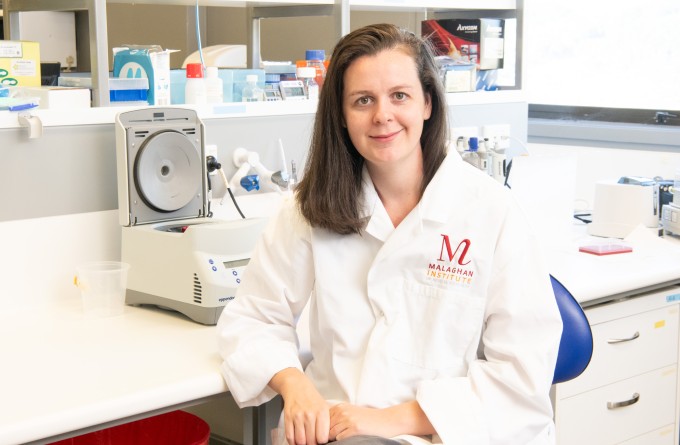7 October 2024
Malaghan Institute postdoctoral researcher Dr Jordan Minnell’s research into self-amplifying RNA is one of a eight nationwide projects recently awarded a Fast Start Project Grant worth $250,000 from New Zealand’s RNA Development Platform.

Dr Rebecca McKenzie, Project Leader in the RNA Technology Development Platform, operating the lipid nanoparticle assembler, a key component for manufacturing RNA therapeutics.
The RNA Development Platform, funded by the Ministry of Business, Innovation and Employment, was established in 2023 to capitalise on the opportunities presented by mRNA technology during the Covid pandemic. It builds on pre-clinical capability developed with support of donors to the Malaghan Institute as part of Vaccine Alliance Aotearoa New Zealand.
RNA Development Platform Co-Director and Deputy Director of the Malaghan Institute Professor Kjesten Wiig says the Fast Start Projects are about getting some quick wins for RNA technology to build capability across New Zealand.
“RNA technology marks a step change in medicine, as disruptive and revolutionary as penicillin and computers,” she says. “These Fast Start Projects encompass a diverse range of areas within RNA research, including the development of messenger RNA (mRNA) vaccines, exploration of disease drivers, formulation of RNA therapeutics and the synthesis of critical reagents for the RNA Platform.”
Dr Minnell’s project, which he is co-leading with Sarah Draper from the Ferrier Research Institute, is about setting up the RNA Platform to leverage self-amplifying RNA (saRNA), which has the potential to further improve RNA-based therapies and vaccines.

Dr Jordan Minnell
The project will involve exploring the use of saRNA technology in the Malaghan Institute’s existing research programme investigating a malaria vaccine candidate. Prior research conducted in the Hermans Laboratory established an mRNA vaccine candidate which has shown to protect against malaria in pre-clinical mouse models. Dr Minnell and his team will be using the Fast Start grant to determine if they can carry over the principals from the mRNA vaccine to an saRNA setting to see how well the perform in fighting malaria infection.
Dr Minnell says building saRNA capability into the RNA Development Platform will be another potent tool in our arsenal when it comes to fighting some really nasty diseases. “I believe it’s the future of RNA technology, which has already shown such huge potential.”
RNA is a chain of molecules that act like instructions to a cell to make specific proteins. Our cells are constantly making RNA as the nucleus provides instructions on what to build at any given time.
“RNA can also be synthesised in a lab. In the case of mRNA vaccines, these manufactured messages contain instructions to make an antigen, a protein that’s found outside or within pathogenic organisms, that immune cells can recognise as harmful and remove,” says Dr Minnell.
Many kinds of proteins can be encoded in RNA to assist in the fight against disease – including cancer. Scientists have been trying to harness the simplicity and elegance of RNA technology for decades. As long as the desired protein and it’s code is known, RNA technology can be used in a number of innovative ways.
However, mRNA is a fragile molecule. It’s not designed to exist outside a cell and degrades rapidly. By the time a shot of custom-made mRNA makes its way from the syringe to the cell that needs it, it’s degraded and useless.
Dr Minnell says the relatively recent discovery of lipid nanoparticles, microscopic bubbles of fat molecules that act as a protective barrier from the outside environment, has revolutionised this technology. “For the first time, artificially-manufactured RNA – enclosed safely in a bubble – can make its way to the desired cell whole and intact, ready to help fight disease.
“What’s more, making mRNA is fast – much faster than other vaccine production methods. The Covid-19 pandemic showed how quickly we can use RNA technology to curb the spread of a virus and protect the global population.”
Self-amplifying RNA (saRNA) is the next generation of RNA technology. Rather than just a list of instructions to make a protein, saRNA also comes with instructions to make itself – a leap forward in the technology’s ability to fight disease.
“Self-amplifying RNA has several key advantages over traditional RNA-based treatments,” says Dr Minnell.
“In the process of amplifying or replicating itself inside a cell, the saRNA also sets off cascades of cellular reactions and promotes interactions which more closely mimic the biological conditions of a cell encountering a foe. This helps mount a more effective immune response with all of the appropriate biochemical signals .”
In other words, as saRNA commissions a cell’s replication machinery to create copies of itself (and the antigen), the process also switches on the cell’s other mechanisms associated with identifying and removing harmful organisms like viruses – more so than current mRNA vaccines. It’s a subtle shift, but by more closely mimicking a proper infection, scientists can create a more effective immune response.
In addition, the ability to create copies of itself also carries the advantage of requiring much lower doses of saRNA to elicit a powerful protective response, making the technology much more efficient.
“One of the huge advantages of this technology is that it’s dose sparing – needing smaller doses for the same effect,” says Dr Minnell. “One molecule of saRNA can do the job of ten regular RNA molecules, so the transformative potential of this technology as a way to quickly and efficiently fight infectious and other diseases is huge.”
Related articles

The nose knows: new research explores next generation of nasal vaccines
2 December 2025

Marsden funding to drive discovery and innovation in cancer, allergy and infectious disease research
5 November 2025

The Detail: The viral drift of misinformation
29 September 2025

Dr Lisa Connor: Finding new ways to target old viruses
24 July 2025

Dr Michelle Linterman: Asking the age-old question
30 April 2025

Kjesten Wiig: bringing life-changing treatments to life
27 February 2025
